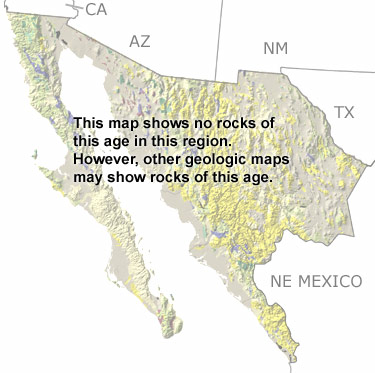

The Silurian in Northwest region, Mexico |
|||||||||||||||||||||||||||||||||||||||||||||||||||||||||||
|
|||||||||||||||||||||||||||||||||||||||||||||||||||||||||||
Paleontology and geologyIn the Silurian, shallow to deep waters of the continental shelf, slope, and ocean basin covered all but the northernmost part of this region, which was near the edge of the continent. Some parts of this region existed as volcanic islands out in the ocean, and other parts had not formed yet. The seas were home to many different invertebrates, including corals, brachiopods, trilobites, graptolites, and conodonts. Fossils of these animals are preserved in some of the limestones, sandstones, and shales deposited in the seas. Most of the Silurian rocks from this region have been removed by erosion or are buried below the surface, but a few small exposures can be found in the north and west. They are too small to appear on this map, but may be included in the undifferentiated Paleozoic rocks. Other more detailed maps may also show them. Some rocks in the north may have been deposited elsewhere and later moved to their present location. Geologists continue to study how and when they formed. |
|||||||||||||||||||||||||||||||||||||||||||||||||||||||||||
|
|
|||||||||||||||||||||||||||||||||||||||||||||||||||||||||||
|
site tour |
about the site |
site map |
site credits |
page credits |
help |
FAQs |
contact |
||


